Coronavirus Today: Closing the gap at school
- Share via
Good evening. I’m Thuc Nhi Nguyen, and it’s Friday, March 19. Here’s the latest on what’s happening with the coronavirus, plus ways to spend your weekend and a look at some of the week’s best stories.
More children may be able to spend more time in their classrooms soon.
The federal Centers for Disease Control and Prevention relaxed some of its coronavirus guidelines for schools Friday, shrinking the minimum physical distance required in certain classroom situations from six to three feet, my colleagues Amina Khan and Howard Blume report.
Reducing the required distance between desks should allow more students to return to in-person classes on a full-time basis instead of using a hybrid model that rotates smaller groups into the classroom.
But don’t get too cozy.
The three-foot rule applies only in elementary school classes where young children are all masked. Middle and high school students, who are believed to spread the coronavirus more easily, should still abide by the six-foot guidelines. Adults on campus should still observe the six-foot rule, and even young students should remain six feet apart in common areas, when masks can’t be worn and while singing, shouting or doing other activities that trigger increased exhalation.
A study of Massachusetts schools helped persuade the CDC to change its guideline. Researchers found that coronavirus case rates among students and staffers were essentially the same in schools that adopted a three-foot rule as in those that followed the six-foot rule.
The World Health Organization already recommends one meter (3.28 feet) of physical distancing in general.
Dr. Monica Gandhi, an infectious-disease specialist at UC San Francisco, was among the experts who praised the CDC action. “Since the requirement of the six-foot distancing rule has been identified as a hindrance to school openings in some situations, this change by the CDC is a welcome one and will hopefully facilitate more school openings here in California,” she said.
School closures last March marked a pivotal moment for Gov. Gavin Newsom as he contemplated whether to issue his statewide stay-at-home order, my colleague Taryn Luna reports in a deep dive into how the nation’s strictest public health guidelines came to be.
The bold move looked brilliant when California suffered a first COVID-19 surge that was much less deadly than in other parts of the United States. But it was only the beginning of an unprecedented health and political crisis. The economic toll of the state’s shutdown, combined with a winter wave that made parts of California the nation’s hardest-hit areas, undermined our status as a national model.
Newsom’s popularity has taken a hit because of his handling of the pandemic. But in the eyes of some, the drastic decision was the only choice.
“If you were the public official facing the possibility that a million people could die if you don’t act, there’s nothing to balance,” said Susan Kennedy, chief of staff to former Gov. Arnold Schwarzenegger and Cabinet secretary for former Gov. Gray Davis.
Newsom is promoting the state’s rapid economic recovery, thanks to a sometimes slow but still steady vaccine rollout. The state was going to rely on Blue Shield of California to take control of the vaccination strategy — but after pushback from counties, that is being revised.
A letter sent by the California Government Operations Agency said local public health officials will have more power in how Blue Shield distributes vaccine doses and how the shots can be used, my colleague Melody Gutierrez reports.
Blue Shield must now consult with a county before recommending an appropriate allotment of vaccine doses. Counties will also be allowed to distribute portions of their vaccine allotment to local clinics and healthcare providers, a power that would have been restricted to Blue Shield and state officials.
Counties that don’t want Blue Shield oversight can sign a separate agreement with the Government Operations Agency.
With the expectation that supply will increase, Newsom said Friday that vaccines could be available to every adult who wants one by early May.
When your turn in line comes and you’re receiving the two-dose vaccines from Pfizer-BioNTech or Moderna, you might feel stronger side effects after the second shot than the first. If you feel tired, feverish or achy, don’t panic. It means the vaccine is working, Khan reports in another story.
The first and second shots are exactly the same. The first primes the immune system, which makes your body ready to launch a more robust response to the second shot.
“It’s just an amplification, basically, of the same process that happens the first time around,” said Dr. Diane Griffin, an infectious-diseases expert at the Johns Hopkins Bloomberg School of Public Health.
By the numbers
California cases and deaths as of 6:46 p.m. Friday:

Track California’s coronavirus spread and vaccination efforts — including the latest numbers and how they break down — with our graphics.

See the current status of California’s reopening, county by county, with our tracker.


What to read this weekend
High school is Zooming by
A year after their last in-person classes, high school students are feeling isolated and lonely. But students in the Alhambra Unified School District are also modeling resilience, my colleague Melissa Gomez reports.
Abigail Velazquez, a freshman, started a new side hustle during the pandemic by selling chocolate chip cookies, cheesecakes and coffee cakes. Meghan Webster, a sophomore, overcame Wi-Fi issues to win a speech contest. Justin Flores is enjoying the extra sleep he can get before virtual classes, but the junior missed goofing around with his baseball teammates.
Not having to see classmates in person was good for senior Lucas Lozano, who was often harassed for being gay. But the social anxiety was soon replaced by worries at home when both of his parents lost their jobs and his grades suffered. To cope, Lozano reads books or goes outside to practice the last color guard routine he learned before campus shut down.
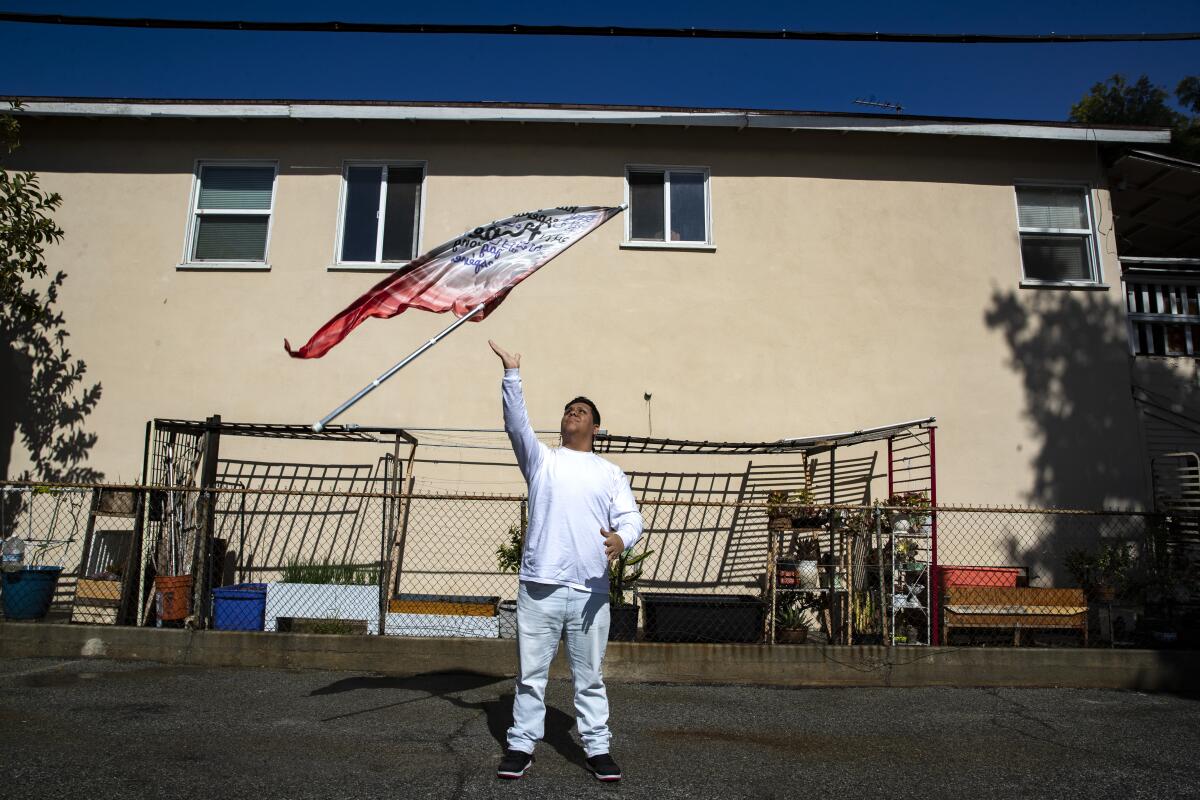
Food is a love language
At least Brennan Villarreal could surf every day.
The 29-year-old line cook was laid off from his job at Lasa, a popular Filipino restaurant, last year when the pandemic forced the closure of dining rooms, bars and nightclubs in Los Angeles. He got the message while on vacation. What was supposed to be a three-week trip to the surfing capital of the Philippines turned into a five-month ordeal when he was stranded overseas because of travel restrictions.
As he burned through his savings, Villarreal also found a new perspective, my colleague Maria L. La Ganga reports.
Villarreal returned to L.A. last summer and found work at a new restaurant only to get laid off again during the holiday surge. He delivered packages for UPS, then returned to the kitchen at the end of January. He was offered a job at Lasa’s successor restaurant, too. The pandemic changed how he considered the option.
“I think it’s maybe a wake-up call to change how things are,” Villarreal said.

Caring for caregivers
Healthcare workers often carry their tools on code carts, a wheeled stack of trays and drawers that contain everything doctors and nurses need to help save a patient’s life. Now, with hospital workers fighting to stay balanced during a stressful pandemic, hospital chaplains are swooping in with their own tool kit: a “Code Calm” cart.
The stations with tea, essential oils, pamphlets and snacks are just one of the ways chaplains at Cedars-Sinai Medical Center and Children’s Hospital Los Angeles are caring for caregivers during the pandemic, my colleague Faith E. Pinho reports.
Healthcare workers struggling to persevere through the pandemic are leaning on the chaplains who usually devote their time to helping hospitalized patients and their loved ones. The support goes beyond religious boundaries. Jillian Katz, an Orthodox Jewish nurse working on Cedars-Sinai’s COVID-19 unit, connected with Rev. Peggy Kelley, a Protestant chaplain.
“It’s really beautiful that we can ignore all the societal standards and just be able to lean on each other,” Katz said. “Spirituality doesn’t have to be about the specifics of religion. It’s just about how we’re all connected — [and] there for each other.”
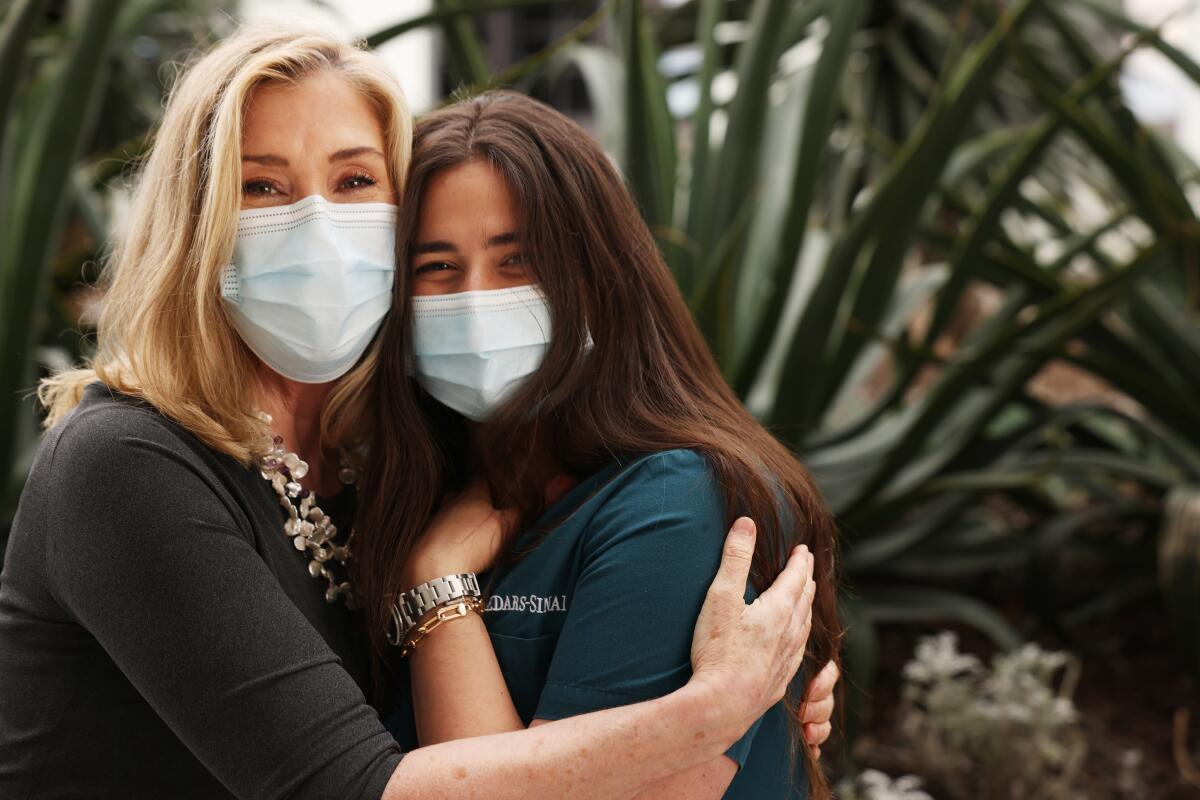
Working together
Whether emotional or financial, we’ve all needed some help to get through this pandemic.
For people in disadvantaged communities searching for additional services but lacking the support to find it, mutual aid groups have been a critical safety net, my colleague Brian Park writes. These initiatives have been busier than ever delivering food, hygiene products and other essential goods to vulnerable populations.
Mobile pantries deliver food to unhoused people. Volunteers on bikes hand off bagged lunches. Some groups focus on helping farmworkers. Others, like No Us Without You, provide food and support for hospitality workers without legal status.
A year after starting the nonprofit, Damián Diaz and Othón Nolasco lead an organization that moves about 160,000 pounds of food a week through its Boyle Heights facility. With a fleet of 30 volunteer drivers, No Us Without You conducts four drive-through contactless food drops each week and serves 1,600 families.
“Undocumented hospitality staff have been feeding Los Angeles for years,” Nolasco said. “Now it’s our turn to feed” them.
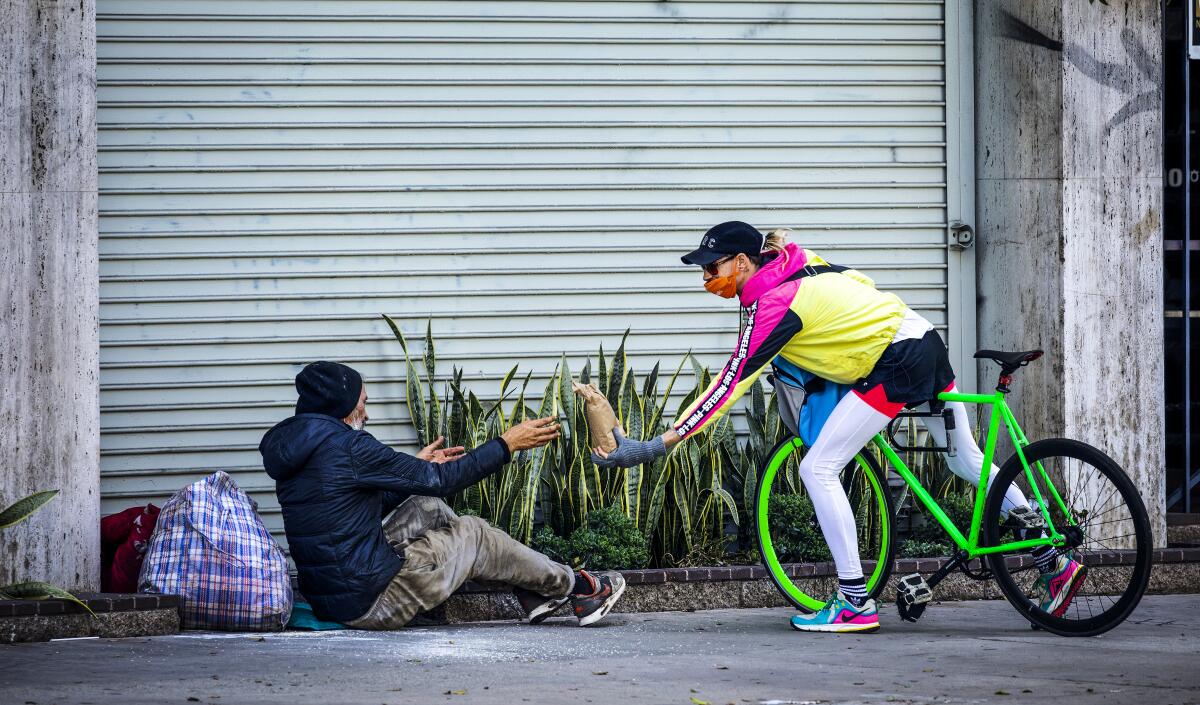
Welcome back, Canter’s
Gradually, Marc Canter, co-owner of Canter’s in Los Angeles, was noticing an increase in foot traffic in the area. Outdoor tables open for dining became busier. The sights offered a glimmer of hope in a dark year.
“The sun is out,” he said, “and there’s a light at the end of the tunnel.”
At long last, the lights turned on at his famous deli on Fairfax Avenue on Monday when Los Angeles County resumed limited indoor dining, my colleague Ruben Vives reports.
Old rhythms returned quickly for some. Four regulars sat in booths as workers prepared roast beef and pastrami sandwiches. Bob Knee, 72, ordered sausage and eggs. To be back in the restaurant that he has visited since he was 16 felt “normal again.”
“It’s wonderful,” he said.
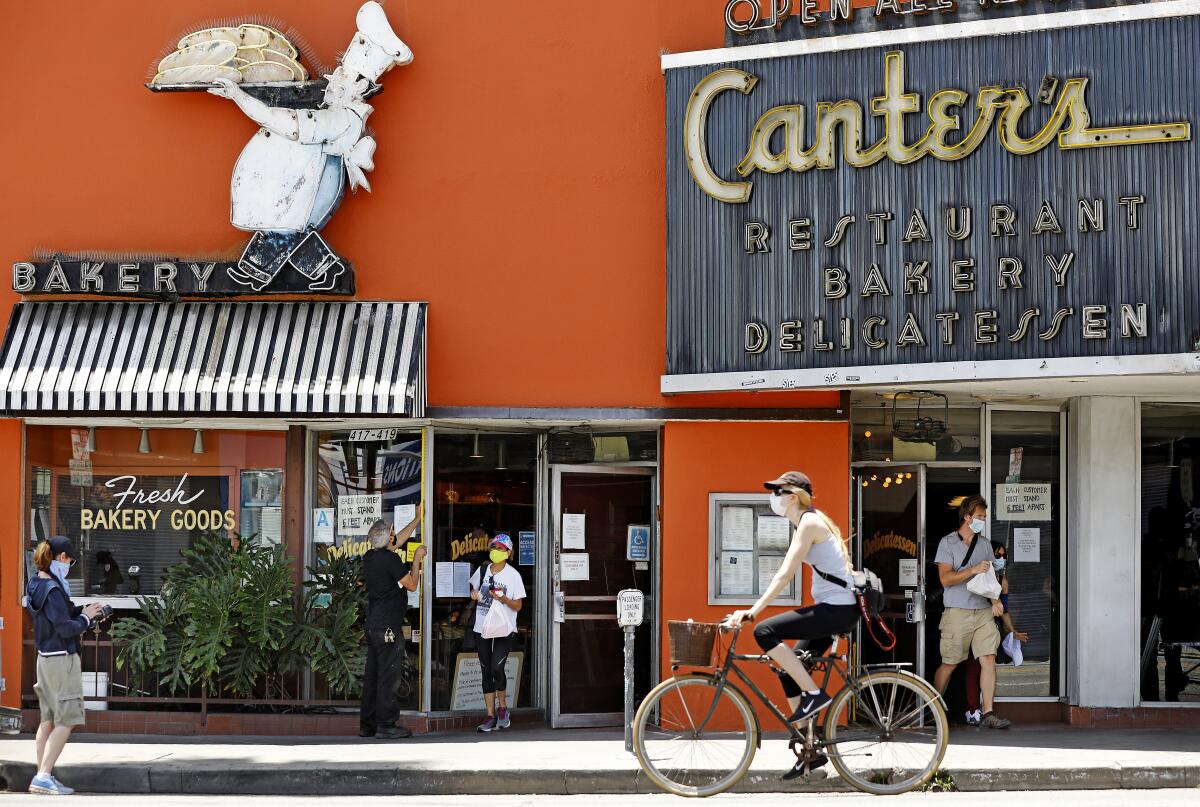
Your support helps us deliver the news that matters most.
What to do this weekend
Get outside. Keep working your way through The Times’ hiking guide with a trip to the Bridge to Nowhere. If you’re resting your legs, take a driving tour through Claremont, which boasts varied architecture. Subscribe to the Escapes newsletter for more travel ideas or The Wild for more on the outdoors.
Watch something great. Our weekend culture watch list includes TV specials on iconic divas like Tina Turner and Aretha Franklin. And in his Indie Focus newsletter’s roundup of new movies, Mark Olsen spotlights “Zach Snyder’s Justice League.” The director releases his cut of the superhero adventure after a family tragedy in 2017 forced him to hand off the project to writer-director Joss Whedon while in mid-production.
Eat something great. Dress up the humble potato with one of 15 recipes, including gnocchi with browned butter and sage. Or get ready for Passover, which begins next weekend, with Julie Giuffrida’s tips for cooking during the holiday. For more, subscribe to our Cooking newsletter and our restaurants critics’ Tasting Notes newsletter.
Go online. Here’s The Times’ guide to the internet for when you’re looking for information on self-care, feel like learning something new or interesting, or want to expand your entertainment horizons.
The pandemic in pictures

Spring football does not necessarily mean teams will be free from chilly weather.
Rim of the World High in Lake Arrowhead practiced through snow and sleet this week leading up to its season opener. Players stretched on the snow-covered field and ran drills across the soggy grass. Offensive lineman Damon Lyons lightened the mood by throwing a snowball before practice.
Schools in San Bernardino County were allowed to resume outdoor sports in early March, and with 14 practices required before playing a game, Rim of the World couldn’t afford to postpone a session because of the weather. The Fighting Scots will start their season Friday against Ontario Christian.
For more on high school sports, sign up for our Prep Rally newsletter, which will make its premiere Monday.
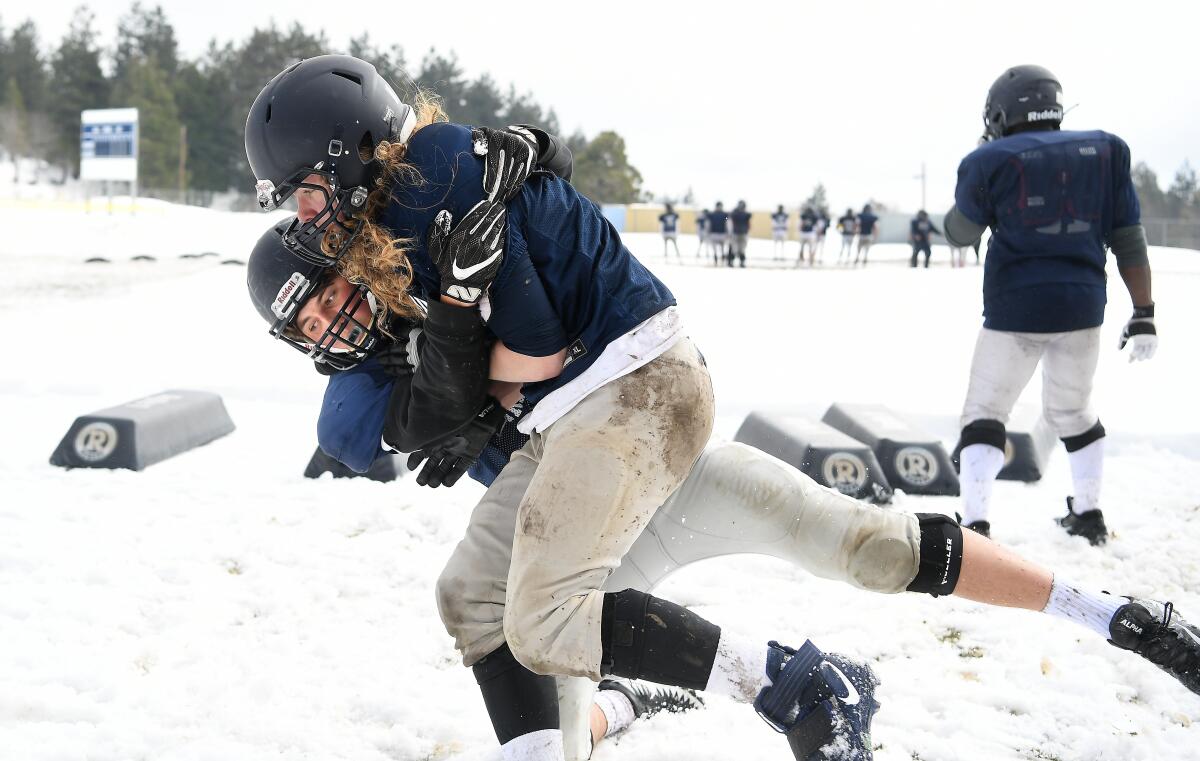
Resources
Need a vaccine? Keep in mind that supplies are limited, and getting one can be a challenge. Sign up for email updates, check your eligibility and, if you’re eligible, make an appointment where you live: City of Los Angeles | Los Angeles County | Kern County | Orange County | Riverside County | San Bernardino County | San Diego County | San Luis Obispo County | Santa Barbara County | Ventura County
Practice social distancing using these tips, and wear a mask or two.
Watch for symptoms such as fever, cough, shortness of breath, chills, shaking with chills, muscle pain, headache, sore throat and loss of taste or smell. Here’s what to look for and when.
Need to get tested? Here’s where you can in L.A. County and around California.
Americans are hurting in many ways. We have advice for helping kids cope, resources for people experiencing domestic abuse and a newsletter to help you make ends meet.
We’ve answered hundreds of readers’ questions. Explore them in our archive here.
For our most up-to-date coverage, visit our homepage and our Health section, get our breaking news alerts, and follow us on Twitter and Instagram.




